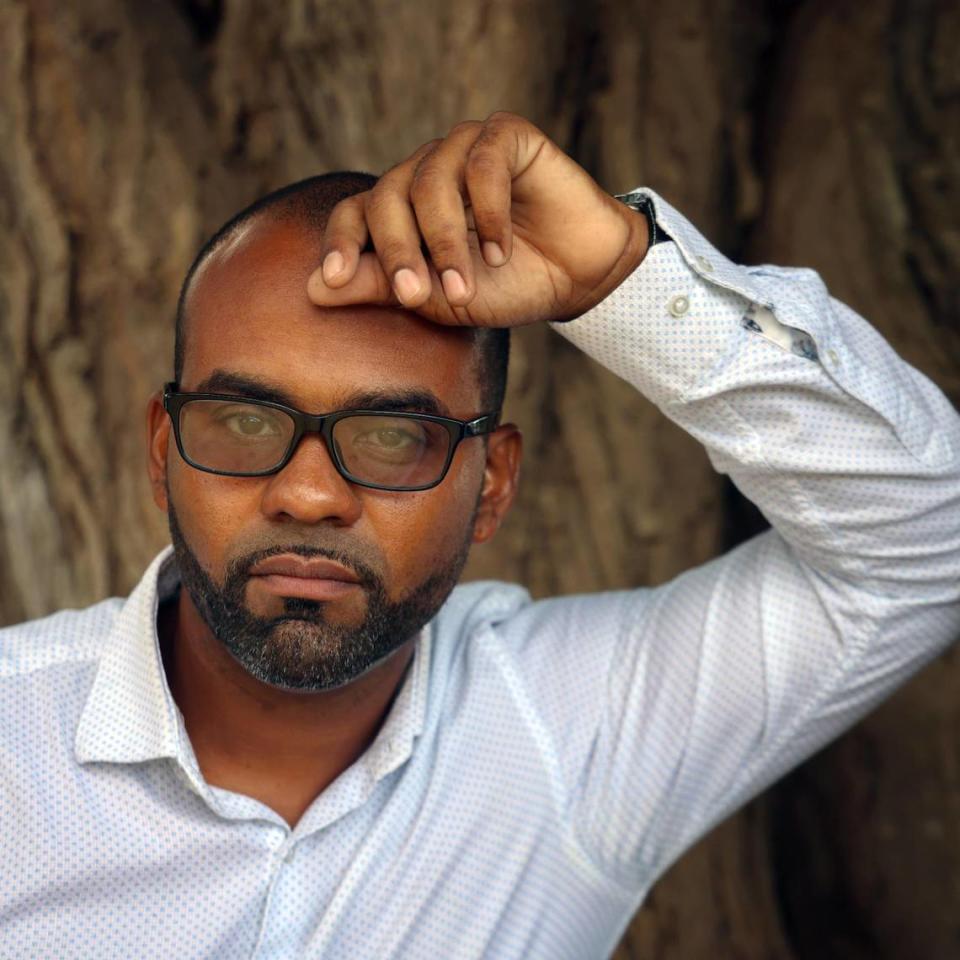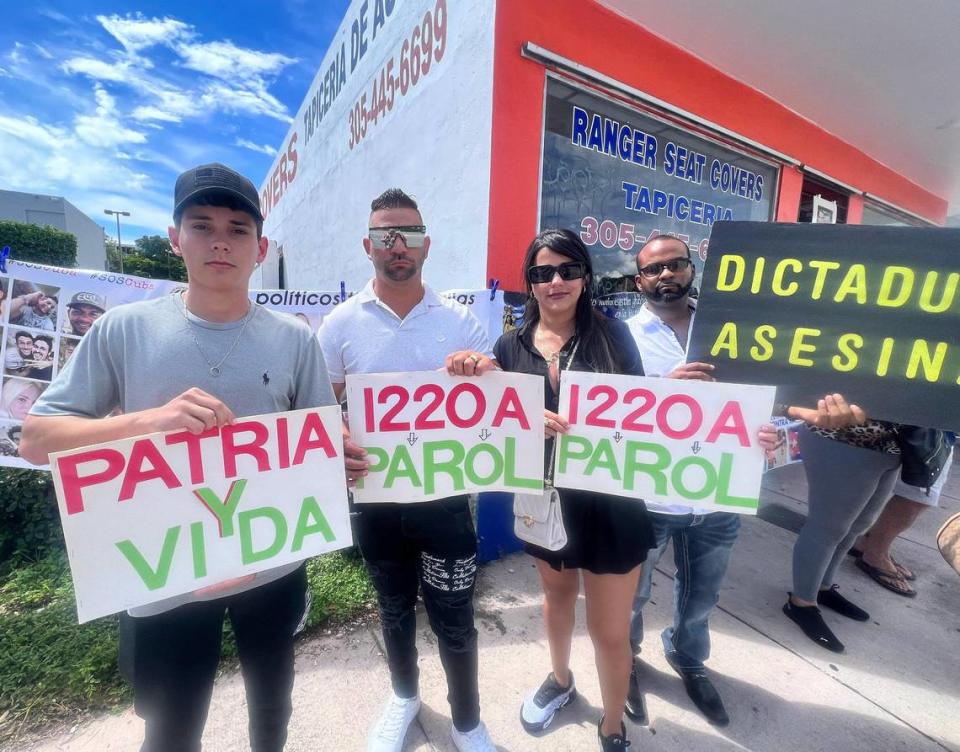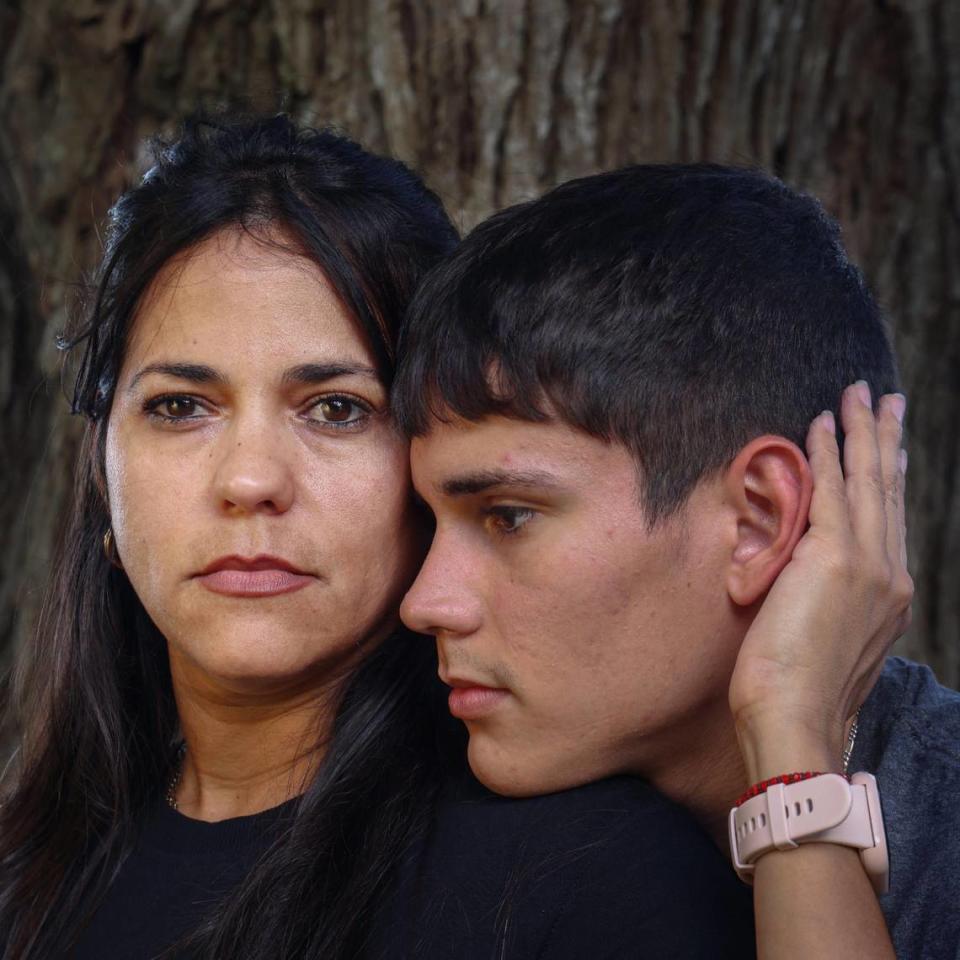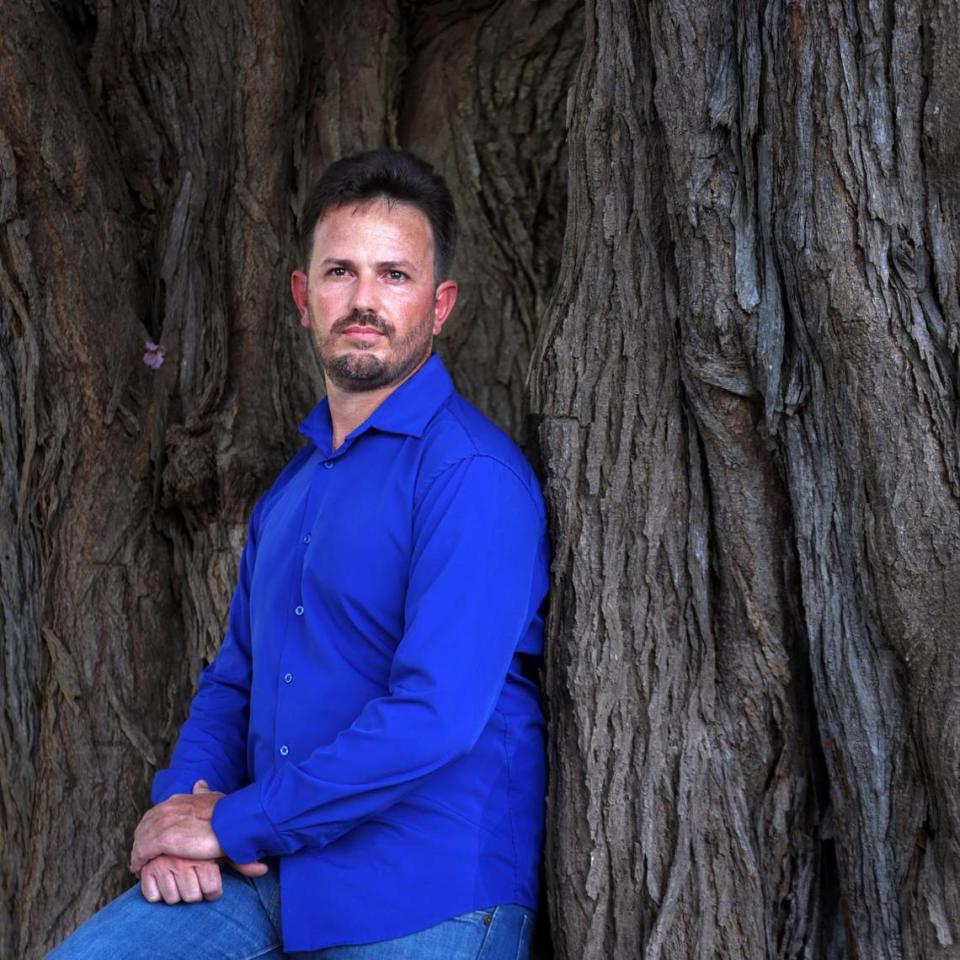A new era for Cuban migrants: Some can’t get green cards despite decades-old law
When Rachel Domínguez and her husband, Andy, reached the U.S.-Mexico border last year, the Havana couple counted on becoming permanent residents of the United States in short order, like generations of Cubans before them.
They were fleeing years of persecution and threats over their opposition to the Cuban government, Domínguez said. State security agents kept tabs on them, greeting them on the street corners, showing up at the kids’ school pick ups and sitting in their garage. The monitoring intensified after the historic July 11, 2021, protests, and they lost their jobs after participating in the demonstrations.
“They would keep you for an entire day, take your phone, and sometimes tell you that you have to behave, that your family didn’t know where you were and they could make you disappear,” she said.
The couple sold their two houses and a car. Ten months after the protests, in May 2022, they flew to Nicaragua. They left her children, aged 12 and 6, behind with their grandparents, unwilling to risk their lives.
For 13 days the couple walked and took buses and trucks from Managua through Honduras and Guatemala. In Mexico, a group of men dressed as policemen kidnapped their group, holding them at gunpoint for an entire night until they were paid off. After the couple was freed, they spent 28 hours in an airtight truck container along with an unaccompanied child, whose foot was squashed by a large suitcase, and an 80-year-old woman who fainted from pain after hurting her hip when the vehicle hit a pothole.
When the couple crossed the Rio Grande — helping the elderly woman navigate the river — into the Texan town of Eagle Pass, American border officials were on the other side.
“They told us everything would be OK,” Domínguez said.
Immigration authorities separated the couple to interview them, and that’s when their trouble began: Border agents granted her husband parole, which allows people to enter the country for urgent humanitarian or public-interest reasons. More importantly, that made him eligible to apply for a green card a year after his arrival under the 1966 Cuban Adjustment Act.
But Domínguez was released with an I-220A document — a form immigration officials give people freed from custody and put in deportation proceedings.
For nearly six decades, Cuban migrants have enjoyed a fast track to permanent residence in the United States through the Cuban Adjustment Act. Now, the federal government has released thousands of recently arrived Cubans from the U.S.-Mexico border with paperwork that an immigration appeals board ruled makes them ineligible to get green cards under the Act. It’s a disruption in the longstanding preferential treatment that Cubans have historically received. And it’s creating a new group of Cuban migrants who are undocumented and fighting to stay in the country.
The Department of Homeland Security did not respond to Miami Herald questions about how many recently arrived Cubans have been released with I-220A documents versus paroles. South Florida lawyers estimate that the number is at minimum in the tens of thousands.
Some immigration judges had been granting green cards to Cubans with I-220As. But Homeland Security appealed those decisions. Last month the Board of Immigration Appeals ruled that Cubans released with an I-220A do not qualify for permanent residency through the Cuban Adjustment Act, a decision that can be reversed only by a federal court or the U.S. attorney general.
READ MORE: This federal ruling will keep many Cubans from getting green cards to stay in the U.S.
Attorneys in Miami say they have seen cases in which family members who fled the island and crossed the border together were given different immigration documents. Recently arrived Cubans said that whether they got parole at the border, or an I-220a form, seemed random and depended on the judgment of the border officer who interviewed them.
Under federal law paroles are granted on a case-by-case basis. U.S. Customs and Border Protection, the Homeland Security agency that handles border security, did not respond to Herald questions about whether an official protocol exists to decide which Cubans get I-220As.
Domínguez said that the group of Cuban women with whom she was processed received I-220As, while the men her husband was processed with were paroled.
“The level of inconsistency they have at the border whether they approve a parole or not is a practice that makes no sense. It’s a lottery,” said John de la Vega, a Miami-based immigration attorney with several clients who have I-220As.
Cubans like Domínguez are now mostly limited to fighting for asylum to stay in the country. But the asylum process is complicated and not a sure shot. Sixty-one percent of asylum claims from Cuban nationals were rejected between 2001 and 2021, according to a report from Syracuse University’s Transactional Records Access Clearinghouse. The process is also lengthy — Dominguez’s next immigration hearing is scheduled for 2026.
Domínguez’s husband could eventually apply for a green card on his wife’s behalf once he becomes a permanent resident. But that’s an expensive, years-long process that hinges on whether her husband’s green card is approved. She’d also likely have to leave the country to apply.
“It’s not that easy to win asylum,” Domínguez said.
Gratitude — and uncertainty
The Herald spoke with nearly a dozen Cubans living in South Florida released with I-220As. They are grateful that the United States allowed them into the country. But the recent ruling has sent shockwaves throughout South Florida’s recently arrived Cubans, who hoped they would be able to quickly become permanent residents.
Several used the same Spanish expression to describe how they had felt when they first heard about the immigration board’s decision: Cayó como un cubo de agua fría. Like getting doused with a bucket of cold water
But some remain hopeful.
“We lost a small battle. But the war is not yet lost,” said Joel Pérez Sa, a Cuban man with an I-220A who arrived in the U.S. two and a half years ago.

The former business owner from Havana, who said that island authorities had repeatedly detained him, was taken in by family who came to Miami in the 1980s. He wants to study computer administration and to get his residency so he can bring over the wife and children he left behind.
“That way they can come in legally and don’t have to go through what I went through,” he said.
On a recent Sunday, a small group carrying Cuban flags and signs protested the immigration board’s decision outside of Miami’s Versailles Restaurant for the second consecutive weekend. They merged with a separate demonstration demanding freedom for the island’s political prisoners. Cars passing by honked in support.
The decision left Abdiel Benítez, a 20-year-old man from Havana, “totally devastated. The threat of deportation puts my life at risk,” he said.
Benítez was at the protest with his family, holding up posters with red and green letters that said “I-220 to Parole” and “Patria y Vida” — Homeland and Life — the name of a song that has become a call for Cuba’s liberation. They left Cuba in February 2022 after protesting in the July 11 protests.

Cuban authorities sentenced one of their relatives to 15 years in prison. Neighborhood pro-government leaders ordered a boycott on the family’s hospitality and cafeteria business. Officials threatened that Benítez would not survive Cuba’s mandatory two-year period of military service for men over the age of 17.
Cuban officials “kidnapped me and took me to the police station. They told me that I was old enough to go to the military service, where many boys died. And that if I didn’t change my way of thinking, I could become one of them,” said Benítez.
Benítez and his family traveled to Nicaragua, then used smugglers to take them to the U.S.-Mexico border. The family was released into the U.S. within a day, after Benítez, who has a blood-cell disorder, suffered a sharp drop in blood oxygen.
“My kid almost died at the border,” said Yelaine González, Benitez’s mother.
González came to Miami with her husband and son because she has a brother here who could take them in. The family is slowly cobbling together a new life in South Florida. They rented an efficiency unit of their own and her son is receiving medical care. Her husband landed a job in construction, while she started working in daycare.
But they all received I-220As at the borders. The family is fighting for asylum without the resources or money to do so.
González carries with her the memories of four decades in Cuba, the trauma of her family’s journey to the United States, and the fears of being sent back to the island.
The stress has left her with heart palpitations, insomnia and rapid weight loss. At one point after moving to the United States, she said, she thought of “putting an end to the anguish.”
“I didn’t do it because my son gave me the strength to move forward,” she said.
But she has nightmares of being deported, she said. In her dreams she’s back in Cuba and cries out until she runs out of breath. Then she wakes up in the United States.
And she hopes, morning after morning, that she will somehow qualify for the Cuban Adjustment Act, become a permanent resident and then a U.S. citizen.

“I could focus on working and getting ahead... and give this country whatever it asks of us,” she said. “It has given us so many opportunities.” Her son would like to join the U.S. Army.
Blessed to be here
Miami immigration lawyer Mark Prada has argued in several cases that releasing Cubans with I-220s is illegal and that the government should have released them with a humanitarian parole. He is looking for federal cases to appeal that could undermine the board’s ruling.
“We are still arguing it even if an immigration judge won’t accept it... because the board is not the last word on this,” he said.
Many of the Cubans with I-220As have ongoing asylum claims, which allows them to get work permits. But without a final immigration status or knowing if they can stay long term, they say it’s difficult to build a career or continue studies in the United States.
Jeans Montero, 41, said he felt “free” once he reached the U.S.-Mexico border. The Havana man studied biomedical engineering in Cuba, repairing diagnostic and laboratory equipment in hospitals. He found a job in the same field in Miami. Montero is currently taking English classes and hopes to become a nurse one day. But he doesn’t qualify for federal student aid or loans that permanent residents or some parolees can apply for.
Despite what he describes as an “immigration limbo,” he says he’s better off here than in Cuba.
“I’m feeling blessed to be here. I can’t stop thanking this beautiful country,” he said.

Rachel Domínguez, the woman who got an I-220A while her husband was given parole, currently paints houses. She studied journalism a decade ago, and dreams of becoming a reporter, or a lawyer.
In Cuba, authorities scared her from pursuing a career as an independent journalist. One time, about 10 years ago, she went to pick up her daughter after school, but officials had taken her child to the daycare’s office.
Domínguez said the girl was playing calmly as state security agents told her: “You are an opposition member... One day you could come get the girl and never see her again.”
Domínguez said her parents are taking care of her children in Cuba until she can send for them. But last month her father died after an embolism. Now, her mother is on her own, and Cuban officials have visited her house.
She hopes to bring over her mother and two children from the island legally. But she can’t do it without residency or citizenship.
Domínguez is now waiting to see how her asylum claim pans out. If its granted she can apply for permanent residency after a year and try to get her family to join her. In the meantime, if she were to travel outside the U.S. to meet with her children somewhere else, her precarious immigration situation means she might not be able to return.
“I feel saved, even without residency,” she said. “But I’m missing a piece.”

